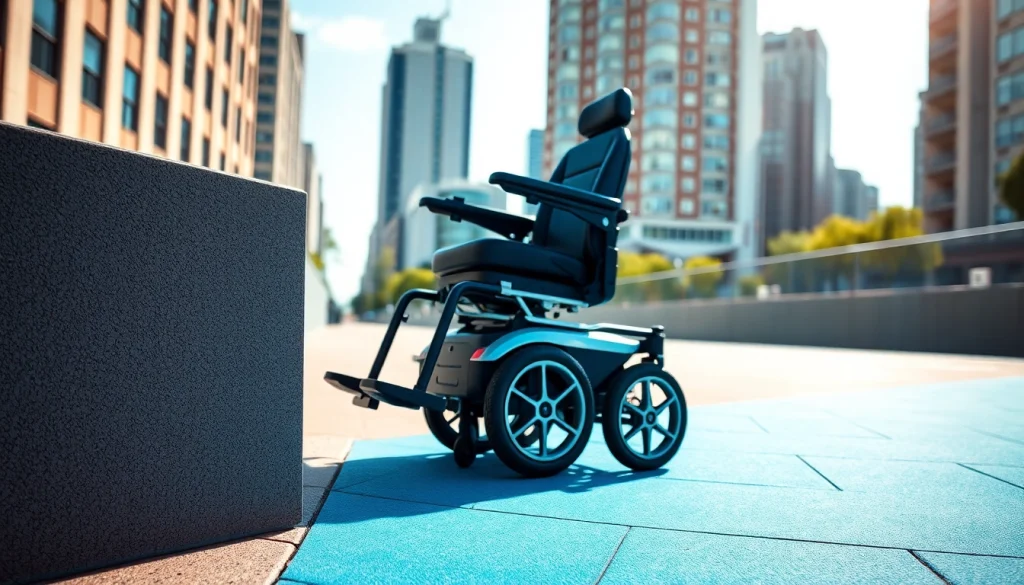Redefining Mobility: How Power Wheelchairs Enhance Independence and Comfort

Understanding Power Wheelchairs
What is a Power Wheelchair?
A power wheelchair, also known as an electric wheelchair, is a mobility device that uses electric motors to propel the user. These wheelchairs provide an alternative means of transportation for individuals with limited mobility due to medical conditions, age-related issues, or physical disabilities. Unlike manual wheelchairs, which require physical effort to maneuver, power wheelchairs enable users to navigate various environments with minimal exertion.
The design of power wheelchairs has evolved dramatically over the years, integrating advanced technology and engineering to enhance user experience. They are equipped with an array of features such as joystick controls, adjustable seating, and, in some cases, smart technology capabilities. Adopting a power wheelchair can significantly improve the quality of life for users, granting them greater independence and mobility.
Key Features of Power Wheelchairs
Power wheelchairs come with a variety of features aimed at maximizing comfort, usability, and accessibility. Key features include:
- Drive System: Power wheelchairs typically feature front-wheel, mid-wheel, or rear-wheel drive systems, each providing unique handling characteristics suited to different environments.
- Joystick Controls: Most power wheelchairs use a joystick for steering and control. This can be customized for various control needs, including proportional controls for more precise maneuvers.
- Seating and Support: Adjustable seating options are essential for comfort and can include reclining backs, elevating leg rests, and even custom seating systems for specific medical needs.
- Battery Life: The life of the battery affects how far and for how long users can operate their power wheelchairs. Modern models often feature lithium-ion batteries for longer life and faster charging times.
- Safety Features: Many power wheelchairs come equipped with safety elements such as anti-tip wheels, speed control adjustments, and automatic brakes to enhance user safety.
Who Benefits from Power Wheelchairs?
Power wheelchairs are designed for individuals who experience difficulty with mobility. Key groups that benefit include:
- Individuals with Neuromuscular Disorders: Conditions like multiple sclerosis or muscular dystrophy can severely limit mobility, making power wheelchairs a vital option for independence.
- Older Adults: Seniors experiencing declining physical capabilities often find power wheelchairs to be life-changing, offering them greater freedom in daily activities.
- Post-Surgery Recovery Patients: After certain surgeries, patients may find walking difficult or impossible; power wheelchairs provide a means of mobility during recovery.
- Individuals with Spinal Cord Injuries: Those who experience paralysis in their lower limbs rely on power wheelchairs to navigate their environments.
Choosing the Right Power Wheelchair
Factors to Consider When Selecting
Selecting the right power wheelchair involves several critical considerations:
- Size and Weight: The wheelchair must accommodate the user’s weight and dimensions. Portable models may be necessary for those who travel frequently.
- Control Type: Depending on the user’s abilities, joystick controls, sip-and-puff systems, or head controls may be more appropriate.
- Terrain Compatibility: Users should assess where they plan to navigate. Some models are better suited for indoor environments, while others can handle rough terrains like sidewalks and trails.
- Adjustability: Features such as adjustable backrests, seat heights, and footrests are critical for comfort and usability.
- Cost and Budget: Price points can vary significantly. Determining what you can afford, including maintenance costs, is crucial.
Common Misconceptions About Power Wheelchairs
Despite their efficiency, power wheelchairs come with several myths that can deter potential users:
- Myth: They are Only for Elderly People: While many seniors use power wheelchairs, they are beneficial for anyone with mobility challenges.
- Myth: They are Bulky and Heavy: Advances in technology have led to the development of lightweight and compact models that are easy to maneuver.
- Myth: They Require More Maintenance than Manual Wheelchairs: Though they do require maintenance, this is manageable and often less frequent than many believe.
- Myth: Using a Power Wheelchair Means You’re Giving Up: In actuality, power wheelchairs can enhance independence rather than detract from it.
Best Power Wheelchair Models Reviewed
Here’s a selection of some of the top-rated power wheelchairs on the market, based on user feedback, safety features, and overall performance:
-
Pride Jazzy 600 Series:
Famed for its durability and comfort, this model provides excellent maneuverability both indoors and outdoors.
-
Permobil C300:
A cutting-edge model that offers advanced standing capabilities and customizable controls to suit user needs.
-
Invacare TDX SP2:
Known for its advanced suspension system, this wheelchair caters to those needing both indoor and outdoor functionality.
-
Drive Medical Cirrus Plus:
A budget-friendly option, this chair is lightweight and foldable, making it perfect for transport.
Power Wheelchair Maintenance and Care
Regular Maintenance Tips
To ensure longevity and optimal performance, regular maintenance of a power wheelchair is essential. Here are some essential maintenance tips:
- Check the Battery: Regularly inspect battery health and charge levels. Replace them as necessary and adhere to proper charging practices.
- Tire Maintenance: Examine tires for wear and proper inflation. Check the condition of the tread and replace if needed.
- Cleaning: Clean your wheelchair regularly to prevent dirt buildup, especially around the electronics and moving parts.
- Inspect Controls: Periodically check the joystick and other controls for responsiveness and looseness.
- Professional Servicing: Schedule routine professional maintenance to detect potential issues before they become significant problems.
How to Extend the Life of Your Power Wheelchair
Extending the lifespan of your power wheelchair takes proactive measures, including:
- Use on Suitable Terrain: Avoid using the power wheelchair on rough terrains unless designed for such conditions to prevent damage.
- Store Properly: Keep the wheelchair stored in a dry, climate-controlled environment to protect against environmental damage.
- Follow Weight Guidelines: Adhere to the manufacturer’s weight capacity to avoid straining the wheelchair components.
- Routine Self-Checks: Take time to perform self-inspections regularly for any unusual sounds or concerns.
- Educate Yourself: Understand how to operate the wheelchair correctly, familiarizing yourself with its functions and limitations.
Recognizing and Troubleshooting Common Issues
Even with proper maintenance, issues may arise. Here’s how to recognize and troubleshoot common problems:
- Slow Operation: If the wheelchair operates slowly, it might indicate that the battery is low or that it requires maintenance.
- Unresponsive Controls: Check connections and the battery; an unresponsive joystick may point to electrical issues.
- Uneven Movement: This could indicate one of the wheels is misaligned or that the tires need inflation or replacement.
- No Power: If the wheelchair doesn’t power on, ensure the batteries are charged, and test switches and connections.
Adapting Your Home for Power Wheelchair Use
Accessibility Modifications to Consider
To maximize the use of a power wheelchair, consider modifying your home for better accessibility:
- Ramps: Install ramps where there are stairs to create smoother access points throughout your home.
- Wider Doorways: Ensure that door frames are wide enough to accommodate the wheelchair easily.
- Low Furniture: Arrange or consider purchasing furniture that is low enough to allow easy access from a seated position.
- Accessible Light Switches: Position light switches and controls at a height that is easy for wheelchair users to access.
Creating Safe Pathways Inside and Outside
Safety is paramount when adapting living spaces for wheelchair use. Consider these tips for creating safe paths:
- Clear Obstructions: Maintain clear pathways free of clutter to prevent accidents.
- Non-Slip Surfaces: Use rugs or mats with non-slip backing to enhance traction and prevent slips.
- Good Lighting: Ensure all areas, especially stairs and doorways, are well-lit to avoid falls.
- Install Grab Bars: In bathrooms and hallways, grab bars can provide additional support and stability.
Integrating Smart Technology with Power Wheelchairs
As technology advances, smart integrations offer innovative ways to enhance power wheelchairs:
- Smart Controls: Utilize smartphone applications that allow users to control their wheelchairs remotely or monitor performance.
- GPS Navigation: Features that provide navigation help users get directions in unfamiliar territories.
- Health Monitoring: Some advanced models include tools to monitor vital signs like heart rate and oxygen levels.
- Voice-Controlled Systems: Integrate voice recognition technology to enhance accessibility for those with limited physical capabilities.
Future Trends in Power Wheelchair Technology
Innovations Shaping the Next Generation
Power wheelchair technology continues to evolve with many promising trends on the horizon:
- Advanced Battery Technology: Future power wheelchairs will likely feature more efficient batteries with longer lifespan and quicker recharge capabilities.
- Environment Adaptation: Technology may soon allow power wheelchairs to adapt to varied terrains automatically, adjusting settings for optimal performance.
- Robotics Integration: Innovations in robotics may lead to power wheelchairs that can perform tasks autonomously, further enhancing user independence.
How AI and Sensors are Enhancing Power Wheelchairs
Artificial intelligence and sensor technology are increasingly being integrated into power wheelchairs:
- Collision Avoidance: Sensors can detect obstacles in the wheelchair’s path and automatically adjust the movement to prevent accidents.
- Personalized Settings: AI can learn user preferences, adjusting speed, acceleration, and route choices for more personalized experiences.
- Predictive Maintenance: Smart sensors can alert users to maintenance needs before they become critical, reducing downtime.
The Impact of Community Support and Resources
The availability of resources and community support plays a critical role in enhancing the experience of power wheelchair users:
- Support Groups: Engaging in community support groups provides users with emotional support and valuable information from shared experiences.
- Accessible Resources: Local organizations often provide guidance on available grants, funding for purchases, and accessible transportation solutions.
- Workshops and Training: Communities may offer training sessions that focus on the safe operation and maintenance of power wheelchairs.







